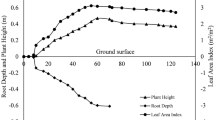Abstract
Crops adapt to variable soil moisture by varying the distribution of their roots and patterns of water absorption. Meanwhile, proper numerical model for predicting soil moisture in croplands especially under high soil moisture conditions is still under discussion. In this study, we evaluated a numerical model for predicting soil moisture in converted soybean fields. A soybean-growing experiment with a converted field model was conducted under the conditions of (a) “G40,” in which the groundwater level was at a depth of 40 cm from the soil surface during the whole experimental period, and (b) “G10-40,” in which there was overmoisture during the early growing stage. Then, a numerical simulation of soil water movement for this growing experiment was conducted with the HYDRUS-1D model. At the end of this experiment, approximately 75% and 60% of the total root mass was concentrated in the topsoil layer (0–10 cm depth) of G10-40 and G40, respectively; thus, the distribution of soybean root might be strongly affected by soil moisture at the early growing stage. The measured soil water consumption rate was relatively high around 30–90 days after seeding in G40, while around 60–90 days after seeding in G10-40. The simulation results improved with the consideration of root distribution variation, changes in evapotranspiration rate and LAI values. The dual-porosity model might be appropriate for describing the soil hydraulic characteristics of soils with macropores, but further improvement is needed in determination of the parameters for high soil moisture.








Similar content being viewed by others
References
Akay O, Fox GA, Šimůnek J (2008) Numerical simulation of flow dynamics during macropore–subsurface drain interactions using HYDRUS. Vadose Zone J 7(3):909–918
Bajgain R, Kawasaki Y, Akamatsu Y, Tanaka Y, Kawamura H, Katsura K, Shiraiwa T (2015) Biomass production and yield of soybean grown under converted paddy fields with excess water during the early growth stage. Field Crop Res 180:221–227
Carsel RF, Parrish RS (1988) Developing joint probability distributions of soil water retention characteristics. Water Resour Res 24:755–769
Coelho EF, Or D (1999) Root distribution and water uptake patterns of corn under surface and subsurface drip irrigation. Plant Soil 206:123–136
Eguchi S, Aoki K, Kohyama K (2011) Agricultural soil-profile physical properties database, Japan: SolphyJ. In: Proceedings of annual meeting of JSDIRE 302-303 (In Japanese)
Feddes RA, Bresler E, Neuman SP (1974) Field test of a modified numerical model for water uptake by root systems. Water Resour Res 10:1199–1206
Furuhata M, Adachi K, Ohno S (2011) Influence of field drainage on dry matter and seed production of soybean in the Hokuriku District of Japan. Jpn J Crop Sci 80(1):65–72 (in Japanese with English abstracts)
Haque MdZ, Sasaki C, Matsuyama N, Annaka T, Kato C (2014) Groundwater level effect on redox potential, on cadmium uptake and yield of soybean. Am J Plant Sci 5:3022–3031
Hirasawa T, Tanaka K, Matsumoto D, Takei M, Ishihara K (1994) Effects of pre-flowering soil moisture deficit on dry matter production and ecophysiological characteristics in soybean plants under drought conditions during grain filling. Jpn J Crop Sci 63(4):721–730
Japan Meteorological Agency (2018) Climate change monitoring report (in Japanese)
Kato C, Nishimura T (2017) Predicting soil moisture condition in arbitrary agricultural lands using the digital soil map and soil physical properties database. Paddy Water Environ 15:159–169
Ministry of Agriculture, Forestry and Fisheries (MAFF) (1997) Planning design criterion of agricultural land improvement project, Planning ‘agricultural water (upland fields)’ (in Japanese)
Schaap MG, Leij FJ, van Genuchten M Th (1998) Neural network analysis for hierarchical prediction of soil water retention and saturated hydraulic conductivity. Soil Sci Soc Am J 62:847–855
Šimůnek J, Šejna M, Saito H, Sakai M, van Genuchten M Th (2013) The HYDRUS-1D software package for simulating the movement of water, heat, and multiple solutes in variably saturated media, version 4.17, HYDRUS software series 3. Department of Environmental Sciences, University of California Riverside, Riverside
Takata Y, Nakai M, Obara H (2009) Digital soil map of Japanese croplands in 1992. Jpn Soc Soil Sci Plant Nutr 80:502–505 (in Japanese with English abstract)
Takata Y, Leon A, Nakai M, Obara H, Kohyama K (2013) Estimation of carbon and nitrogen content in surface horizon using “Soil Information Web Viewer”. J Jpn Soc Soil Phys 123:117–124 (in Japanese with English abstract)
Yates SR, van Genuchten M, Th Warrick AW, Leij FJ (1992) Analysis of measured, predicted, and estimated hydraulic conductivity using the RETC program. Soil Sci Soc Am J 56:347–354
Acknowledgements
This study was conducted with the support of JSPS KAKENHI (Grant No. JP15K18756). The authors wish to thank the Tohoku Agricultural Research Center of Japan for providing soybean seeds. As well, we would like to thank Mr. Rikuto Toda, a graduate of the Faculty of Agriculture and Life Science, Hirosaki University, and Dr. Songtao Li, a graduate of the United Graduated School of Agriculture, Iwate University, for their help in conducting growing experiments.
Author information
Authors and Affiliations
Corresponding author
Additional information
Publisher's Note
Springer Nature remains neutral with regard to jurisdictional claims in published maps and institutional affiliations.
Rights and permissions
About this article
Cite this article
Kato, C., Sasaki, C., Endo, A. et al. Predicting soil water movement in converted soybean fields under high moisture condition. Paddy Water Environ 17, 55–61 (2019). https://doi.org/10.1007/s10333-019-00696-4
Received:
Revised:
Accepted:
Published:
Issue Date:
DOI: https://doi.org/10.1007/s10333-019-00696-4




